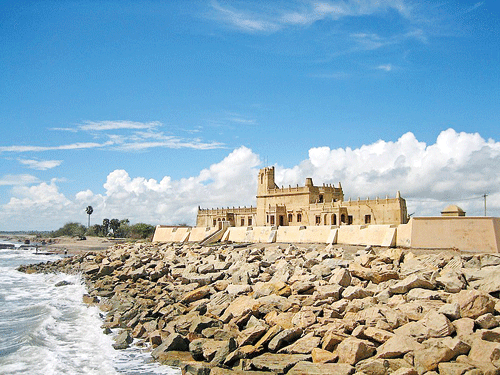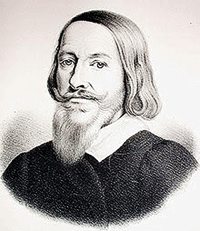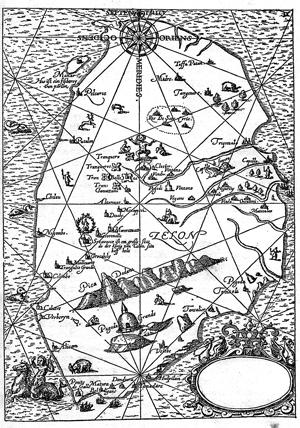400 years ago: A tale of two Danish expeditions

Still standing: Fortress Dansborg at Tranquebar, South India
Some 400 years ago, a decisive encounter took place at the court of Christian 1V (1577-1648) in Copenhagen, Denmark which had a profound impact of commerce and trade in the East.
The Danish East India Company founded in 1616 was funded largely by Christian IV, a notable Danish monarch. King Christian expended large sums of money to build, equip and service ships to serve the Danish East India Company to compete with the Portuguese Dutch, British and French.
He embarked on a project — a daring, expensive and whimsical mission to outdo his European counterparts – two competing fleets were pitted against each other to make the voyage to China. The first, to be led by Jens Munk was charged to chart a shorter, faster though more arduous course from Northern Europe through the North West Passage over North America and Canada to China.
The second more accepted route was 10,500 miles via the Azores and Cape Verde Islands hugging the African coastline, bypassing the Cape of Good Hope, on to the Coromandel Coast, across the Indian Ocean to China. On November 18, 1618 a fleet of five ships sailed out of Copenhagen Harbour under the command of the young Over Gjedde (1577-1648). Two warships Elephant and David were to provide security for the fleet from attack from pirates and enemy warships. The other three were freighters Copenhagen, Christian and Ostend. The voyage lasted four years, and the expedition, from its inception was bedevilled by mutinies, shipwrecks, pirate attacks, court martials and executions and scurvy – a disease caused by the lack of Vitamin C.
Christian IV had entrusted the young nobleman with the onerous task of forging a trade pact with Senarat, King of Kandy.Gjedde had to contend with two experienced Dutchmen who had served with the Dutch East India Company – Marselis de Boshouwer and Roland Crappe, who had experience transacting business at the highest level with Sri Lankan and Indian potentates at their courts.

Portrait of Admiral Over Gjedde[1594-1660
As Commander of the fleet, Gjedde was entrusted with making all the important decisions regarding the trade in spices in Sri Lanka.
By the time the fleet had sailed into the Cape of Good Hope, 200 men had died of scurvy. These and other incidents troubled the inexperienced Gjedde. But on the 16th May 1619 he had something to cheer about as reflected in his log entry;
“This morning we perceived with great joy the promised land of Ceylon.”
On landing however, he was distraught to hear that Marselis de Boshouwer had died eight months earlier and his corpse had been embalmed and preserved to be displayed to the King of Kandy’s envoy.
The papers presented by de Boshouwer to King Christian IV in 1615 were dismissed as a forgery. The Kandyan King Senarat too dismissed the documents’ demands, but much to his relief, offered Gjedde access to the spice trade.
Meanwhile one of the fleet’s vessels was reported shipwrecked near Karaikaal, South India. Only 14 of the crew of 200 including Roland Crappe had survived and they were taken prisoner to the court of Raghunath Nayak in Tanjore. Gjedde was then informed by Crappe who had been freed by his captors to meet Raghunath to set up a trade in spices and particularly pepper for which this district was famous.

Map of Sri Lanka-16th Century
Sailing from Trincomalee on September 15, Gjedde was on board the Elephant anchored offshore near Tranquebar (Tarangambadipatanam). Raghunath and Gjedde finally signed the first Indo-Danish treaty in October 1620, that allowed the Danes to set up a fortress at Tranquebar. Grasping the opportunity, Gjedde soon prepared to build a factory, warehouses and a fortress (Fort Dansborg).
Visiting Tranquebar in 1986, I noted all that remained of the fortification and ramparts facing the Indian Ocean was mere rubble tumbling into the sea. But the Lutheran Church dating from the 18th century was still looking stately.
For Jens Munk’s crew of the Lamprey and the Unicorn, the North West Passage proved to be well beyond his capabilities. For four centuries, frail vessels both of timber and later steel had attempted to make their way through this dangerous route. Almost every year since 1497 when John Cabot (during the rule of Henry VII) sailed from England, they never made it. It was only as late as June 1903, that Norwegian explorer and master seaman Captain Roald Amundsen sailing from Christiana, Norway, powered his vessel from the Atlantic through the open seas to the Pacific – the shortest course to China.
By September 1619, three months since they left Copenhagen, the climate and weather were all stacked against the crew, the sudden storms that frequent these seas proving formidable. They reached Hudson Bay but were in serious jeopardy. Trapped by huge glaciers and large fast-moving slabs of ice sheets and freezing cold; one by one, the scurvy – the dreaded disease of the seamen took its toll.
By June, just three of them were cooped up in captain’s cabin, and Munk had a premonition he would die soon. The following extract is from his diary made on June 4, 1620.
“Since I no longer have any hope of living I can only pray to God that we may be found by some good Christians and for-God’s sake they will cause my poor corpse together with the others to be buried…
Herewith, I say goodbye to the world and give my soul into God’s keeping.”
Controversially he is believed to have survived and made it back to Denmark.
Three centuries later on August 9, 1964 the Jens Munk Memorial Expedition from Denmark succeeded in locating the very spot the Unicorn had sunk. Several artefacts belonging to the vessel were recovered including the log in which Munk had made his diary entries. The ice and snow which killed the crew of the Lamprey and Unicorn somehow had preserved the evidence of this tragic expedition.
The original plan of a shorter route to China never crystallised. Christian IV’s plan of deploying Sr Lanka as a stopover destination also was never realised to its full potential.
Over Gjedde’s major contribution for which he will be remembered was the establishing of a fortified township known as Fort Dansborg at Tranquebar.
The great race was at an end and Over Gjedde had won.
Searching for an ideal partner? Find your soul mate on Hitad.lk, Sri Lanka's favourite marriage proposals page. With Hitad.lk matrimonial advertisements you have access to thousands of ads from potential suitors who are looking for someone just like you.


